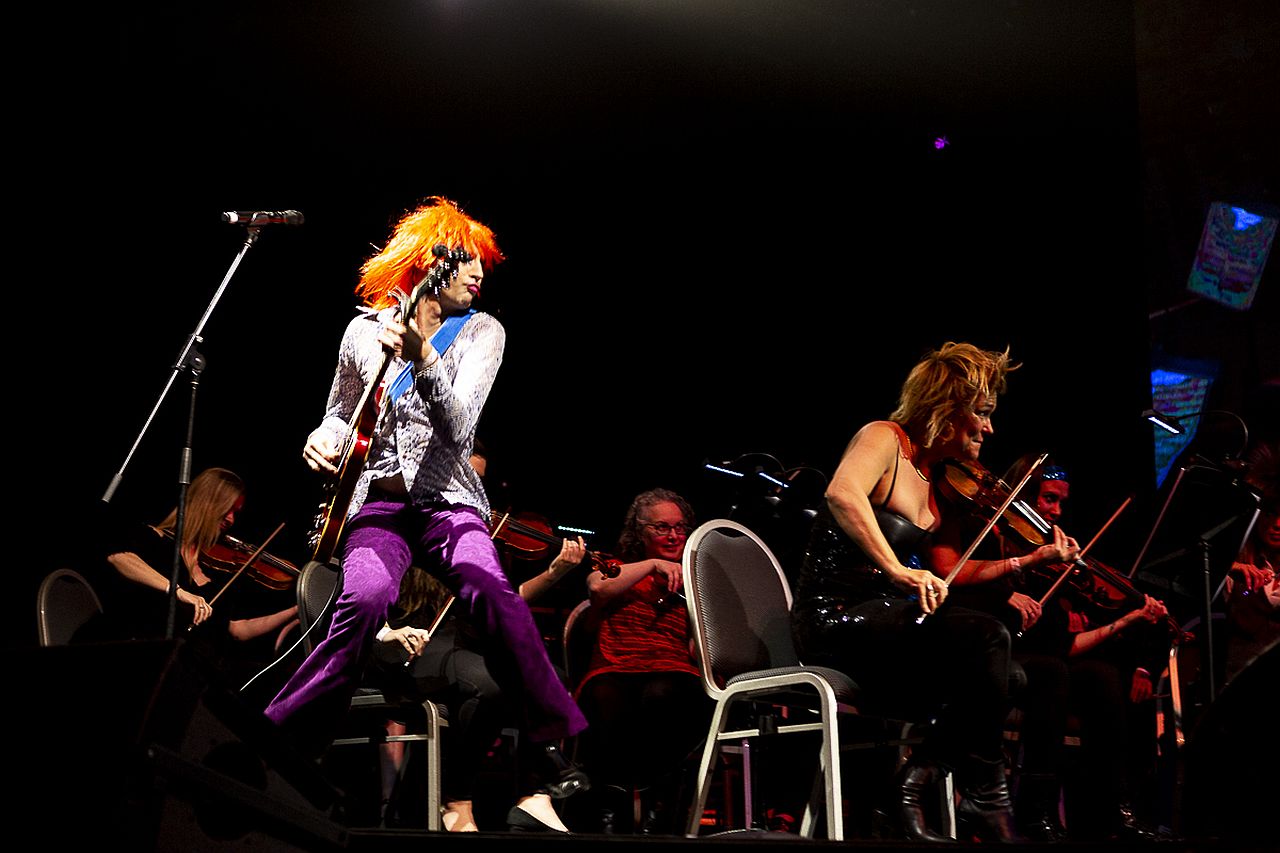Image description: Performers from Stardust. On the left, someone plays the guitar very passionately, as wears a long orange wig and purple pants. On the right, a masc figure sits on a chair, playing a violin, wearing a black corset. Other musicians play instruments in the background.
By Susannah Wong
In case the name didn’t give it away, Stardust is a tribute to the best of Bowie, spanning the Master of Reinvention’s entire back catalogue. Stardust is the Perth Symphony Orchestra (PSO)’s return since their last concert in late February.
For those wondering what to expect, Stardust, like PSO’s other tribute shows (they’ve previously done Nirvana, The Doors and George Michael), is your traditional pub tribute show, only dialled up to eleven – with orchestral backing, some awesome vocals from local singers Steve Hensby and Addison Axe, and a light show expected of a stadium gig.
We start the night with Under Pressure – a banger for sure, but a strange choice in that it’s more of a Queen song than a Bowie standard. Nevertheless, it’s a great way to showcase the evening’s two featured vocalists, and a personal favourite – so no complaints here. It was strong starter, not departing too much from the studio recording.
Next up is Fashion, the second single from the 1980 album Scary Monsters. It’s here that Elise Chong’s conducting skills really shine. While it’s every conductor’s job to lead the ensemble, a great conductor inspires the orchestra to love what they play. It was clear Chong was enjoying herself, and it made all the difference; everyone on stage was having a good time, and, in turn, so was the audience.
The Man Who Sold the World follows, and it’s reimagined as a grandiose, melancholy and cinematic experience – and is all the better for it. Nice.
Fourth and fifth are the funk disco tracks Golden Years, and the Ziggy Stardust opener Five Years, both sung by Hensby. Both were solid offerings; Hensby has a natural ease with the audience, and undeniably owns the stage.
The iconic Life on Mars sees vocal duties switch to Addison Axe, and she really channels the androgyny and presence of Bowie, and absolutely nails the song’s climactic note.
Following is Dance Magic from Jim Henson’s Labyrinth, and things get a little cringey here, with a cute but drawn-out introduction in same vein as the film. A fun time, but really only for Labyrinth fans (fortunately there were a lot of them). Also, a shout-out to the violinist dressed as Bowie’s Jareth, mullet and all. That’s some serious dedication.
Bowie classics Ashes to Ashes and Heroes conclude the first half, and they’re shaken up from their original recordings – Ashes to Ashes is reimagined as a Bjork-esque ballad, and Heroes as an up-tempo, feel-good number. Whether or not this works is up to personal preference, but it’s definitely a bold move.
The second half starts with Ziggy Stardust, a true classic, and it’s more than done justice here. Hensby emerges dressed as the titular space rocker, guitar in hand, and it all comes together to prove why Ziggy is one of Bowie’s finest tracks. Everything is tight, and it’s easily the best performance of the evening so far.
Then comes the unexpected standout of the show; the 1997 track, I’m Afraid of Americans -a bitingly timely choice. Axe’s shredding rock vocals are the star here, on top of a weird but wonderful pizzicato string arrangement from the orchestra. The song’s mood constantly changes, and the band keeps us guessing at every turn.
Space Oddity features some epic vocal work from Hensby, and the string arrangement is undeniably beautiful, but I really miss that upbeat acoustic guitar riff that made the original arguably Bowie’s most iconic song. Nothing technically wrong though, and it’s more than enough to get the audience singing and filming from their seats.
Lazurus, from Bowie’s penultimate album Blackstar, is reimagined as a requiem. It’s dedicated to both the artist himself, and PSO founding chairman, Michael Spillane. The orchestration is handled delicately, and makes for a very moving tribute.
The final songs are Changes, Rebel Rebel, Jean Genie, Let’s Dance and Modern Love. These are the Bowie classics, and it’s understandably at this point that the audience really get excited, as the orchestra smashes out one hit after another almost flawlessly.
Changes is played with a Beatles-esque brass and woodwind arrangement that only add to the original arrangement. Rebel Rebel opens with a symphonic version of the ubiquitous riff, complimented by some very solid work from the drums and rhythm section, retaining the song’s rock edge. It segues nicely in Jean Genie, and the number only gets better when Hensby unexpectedly busts out a mind-blowing harmonica solo.
Part of the encore, Let’s Dance, doesn’t diverge too far from the recording, and lets the band take the lead with orchestral backing. If seven-hundred nostalgic, dancing Bowie fans are anything to go by, it was the right call. It was a tough act to follow, and while the final song, Modern Love, didn’t bring quite the same level of energy as its predecessor, it did feature a crowd-pleasing sax solo, and got the orchestra playing on their feet. It was undeniably unique, and showcased a sense of fun that you would never see from other symphony orchestras.
What stands out the most about Stardust is how the musicians really enjoyed being involved, and the audience enjoyed the show in kind. It was great to see such a high-calibre production run exclusively by WA musos, and Stardust provided desperately-needed relief from the concert famine brought on by 2020.
Looking forward to seeing what PSO do next.
Image courtesy of Karen Lowe

